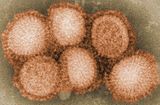
Back فيروس الإنفلونزا أ H7N9 Arabic Vogelgrippe H7N9 German Influenzavirus A subtipo H7N9 Spanish Virus de la grippe A (H7N9) French 甲型流感病毒H7N9亞型 GAN 甲型流感病毒H7N9亞型 HAK H7N9 Icelandic Influenzavirus A sottotipo H7N9 Italian H7N9亜型 Japanese H7N9 Korean
| Influenza A virus subtype H7N9 | |
|---|---|
| Virus classification | |
| (unranked): | Virus |
| Realm: | Riboviria |
| Kingdom: | Orthornavirae |
| Phylum: | Negarnaviricota |
| Class: | Insthoviricetes |
| Order: | Articulavirales |
| Family: | Orthomyxoviridae |
| Genus: | Alphainfluenzavirus |
| Species: | |
| Serotype: | Influenza A virus subtype H7N9
|
| Influenza (flu) |
|---|
 |
Influenza A virus subtype H7N9 (A/H7N9) is a subtype of the influenza A virus, which causes influenza (flu), predominantly in birds. It is enzootic (maintained in the population) in many bird populations.[1] The virus can spread rapidly through poultry flocks and among wild birds; it can also infect humans that have been exposed to infected birds.[2]
A/H7N9 virus is shed in the saliva, mucus, and feces of infected birds; other infected animals may shed bird flu viruses in respiratory secretions and other body fluids.[2]
Symptoms of A/H7N9 influenza vary according to both the strain of virus underlying the infection and on the species of bird or mammal affected.[3][4] Classification as either Low Pathogenic Avian Influenza (LPAI) or High Pathogenic Avian Influenza (HPAI) is based on the severity of symptoms in domestic chickens and does not predict the severity of symptoms in humans.[5] Chickens infected with LPAI A/H7N9 virus display mild symptoms or are asymptomatic, whereas HPAI A/H7N9 causes serious breathing difficulties, a significant drop in egg production, and sudden death.[6]
In mammals, including humans, A/H7N9 influenza (whether LPAI or HPAI) is rare; it can usually be traced to close contact with infected poultry or contaminated material such as feces.[7] Symptoms of infection vary from mild to severe, including fever, diarrhoea, and cough; the disease can often be fatal.[8][9]
The A/H7N9 virus is considered to be enzootic (continually present) in wild aquatic birds, which may carry the virus over large distances during their migration.[10] The first known case of A/H7N9 influenza infecting humans was reported in March 2013, in China.[11] Cases continued to be recorded in poultry and humans in China over the course of the next 5 years. Between February 2013 and February 2019 there were 1,568 confirmed human cases and 616 deaths associated with the outbreak in China.[12] Initially the virus was low pathogenic to poultry, however around 2017 a highly pathogenic strain developed which became dominant. The outbreak in China has been partially contained by a program of poultry vaccination which commenced in 2017.[13]
Bird-adapted A/H7N9 transmits relatively easily from poultry to humans, although human to human transmission is rare. Its ability to cross the species barrier renders it a potential pandemic threat, especially if it should acquire genetic material from a human-adapted strain.[14][15]
- ^ "Influenza (Avian and other zoonotic)". who.int. World Health Organization. October 3, 2023. Retrieved May 6, 2024.
- ^ a b "Prevention and Antiviral Treatment of Bird Flu Viruses in People | Avian Influenza (Flu)". cdc.gov. Centers for Disease Control. April 19, 2024. Retrieved May 8, 2024.
- ^ "Bird flu (avian influenza)". betterhealth.vic.gov.au. Victoria, Australia: Department of Health & Human Services. Retrieved May 9, 2024.
- ^ "Avian influenza: guidance, data and analysis". gov.uk. November 18, 2021. Retrieved May 9, 2024.
- ^ "Avian Influenza in Birds". U.S. Centers for Disease Control and Prevention (CDC). June 14, 2022. Retrieved May 6, 2024.
- ^ "Bird flu (avian influenza): how to spot and report it in poultry or other captive birds". United Kingdom: Department for Environment, Food & Rural Affairs and Animal and Plant Health Agency. December 13, 2022. Retrieved May 6, 2024.
- ^ "Frequently Asked Questions on human infection with influenza A(H7N9) virus, China". World Health Organization. April 5, 2013. Archived from the original on February 13, 2014. Retrieved April 9, 2013.
- ^ "Avian Influenza A(H7N9) virus". Food and Agricultural Organization of the United Nations. June 1, 2022. Retrieved July 15, 2024.
- ^ "Avian influenza: guidance, data and analysis". gov.uk. November 18, 2021. Retrieved May 9, 2024.
- ^ Joseph U, Su YC, Vijaykrishna D, Smith GJ (January 2017). "The ecology and adaptive evolution of influenza A interspecies transmission". Influenza and Other Respiratory Viruses. 11 (1): 74–84. doi:10.1111/irv.12412. PMC 5155642. PMID 27426214.
- ^ "The fight against bird flu". Nature. 496 (7446): 397. April 2013. doi:10.1038/496397a. PMID 23627002.
- ^ "2010-2019 Highlights in the History of Avian Influenza (Bird Flu) Timeline". Avian Influenza (Bird Flu). U.S. Centers for Disease Control and Prevention (CDC). June 3, 2024. Retrieved July 16, 2024.
- ^ "Risk assessment of avian influenza A(H7N9) – eighth update". UK Health Security Agency. January 8, 2020. Retrieved July 15, 2024.
- ^ Cite error: The named reference
European Centre for Disease Prevention and Control_2017was invoked but never defined (see the help page). - ^ Tanner WD, Toth DJ, Gundlapalli AV (December 2015). "The pandemic potential of avian influenza A(H7N9) virus: a review". Epidemiology and Infection. 143 (16): 3359–3374. doi:10.1017/S0950268815001570. PMC 9150948. PMID 26205078.